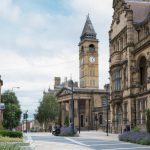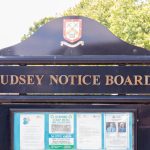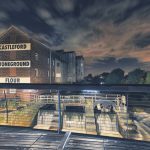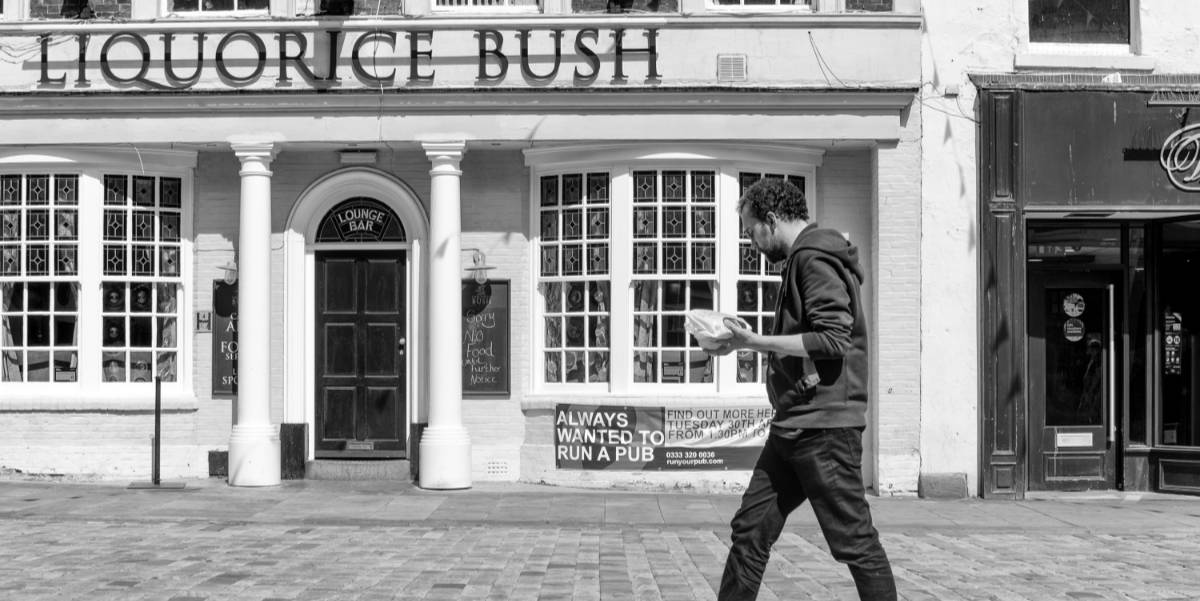
Visit the home of a treasured English candy when you travel to Pontefract to explore.
Pontefract is a West Riding town whose population tops 30,000 people on a good day. A large town respected for its castle; Pontefract also has a long history in coal mining. It is also a market town, has its own racecourse, and is, all in all, doing quite well for a tourist town with a reasonably small population. This article contains everything you need to know for a bit of Pontefract urban exploration. Is it a good place to go on holiday? Stick around to find out. First things are first though: what is Pontefract most famous for?
What is Pontefract famous for?
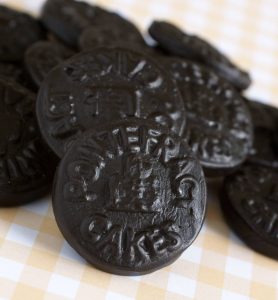
Image: David Pimborough/Shutterstock.com
Pontefract is probably best known worldwide for its famous Pontefract cakes. These are not traditional baked goods but are liquorice sweets. No one knows for sure when the town embraced the sweet treat, however, it is possible that their origin dates back as far as the 16th Century. Who knows? Whatever if you like liquorice you will love them and where better to eat one than in the town itself!
Early History of Pontefract
The name Pontefract seems odd, particularly when we compare it to other old English towns. The name translates to Latin, from the word Pons, which means a bridge, and Fractus, which means broken. So before we even truly begin delving into the history, we already know that at some point a bridge was broken here for long enough that it became part of the town. If your Ponte is also Fractus then we suggest mending it before it goes this far. That’s how weird place names are born.
In fact, history records that Pontefract was two separate settlements up until King William came north. These were Tanshelf and Kirkby. The settlement spanned the water across the River Aire. When they learned William was on his way, local rebels broke the bridge so that he couldn’t get his minions across it. This is what we call constructive vandalism.
Back in March 2017, local construction workers dug thirty Roman skeletons out of the ground under the town. Dated to between 200 and 300 AD, the skeletons also came with artefacts such as clothing and pottery. Experts think they were farmers or builders and that their presence here probably points to something of value being nearby. What that thing of value has yet to unearth itself.
There was an Iron Age chariot dug up from under the A1 at Ferry Friston. The chariot resides in the Pontefract Museum and teaches us that we already had chariots here before the Romans arrived. Likely these types of chariots were for racing. You can imagine early Pontefract residents crowding around an early racetrack to watch them compete.
Pontefract doesn’t make an appearance in the Domesday Survey, probably because Yorkshire was a little wild and untamed. The fact that it has a castle and that castle was a product of a Norman – Ilbert de Lacy – in 1070, we can conclude that it was an unruly town. The Normans built their castles in places they needed to control. If de Lacy thought his newly inherited lands were likely to uprise against his king, he’d have had them all killed using this very castle. So while it is a lovely local attraction nowadays, the castle might not have been so prone to good vibes back then. It is a lot smaller than it was, too. The ruins and round tower date to the 11th century, though the Piper Tower and the remnants of a chapel are the oldest parts of the building.
The city of Wakefield contains 4 separate towns, none of which are mentioned as separate entities in the Domesday Survey. It’s likely that the tax officials got to the outskirts and decided it was not a safe place to survey. Fortunately, there are church records from around 1090, about 4 years after the survey was complete. So we know it was there, and we know it was rebellious, and frankly, who needs more than that? Oh right, there’s still a fair bit of history to get through.
Medieval Times in Wakefield Borough
At some point in the medieval period, Pontefract became a market town. The local All Saint’s Church first opened back in 1300 but it has had several refurbishments over the years. Very little of the early church remains today. What we do know is that Pontefract people continued to prove their rebellious nature inside the church. In 1536, a series of riots broke out in Yorkshire. The people of the north were incredibly furious over Henry VIII’s dissolution of the monasteries.
They call this period the Pilgrimage of Grace. Everyone hated the changes to the church. The fact that he got excommunicated looked awful to the rest of the world. People in England didn’t care for it one bit. Especially in Pontefract, when the preacher was removed from the church and taken to the castle for holding because he was urging the people to be patient. Evil man.
Going back a little farther, the Pontefract area allied with King Eadred and the Archbishop of York against the Vikings. In this area, it was Eric Bloodaxe who tormented the populace. Although there are no thorough records of how this went, Pontefract would make the perfect place to stow troops to see off the invaders. At this time, the town was still part of the Tanshelf estate.
In 1090 de Lacy built the priory of St John of Pontefract, which is another reason the people were so annoyed that Henry VIII closed the monasteries. St Clement’s chapel inside the castle didn’t exist until 1090. St Giles Church opened in 1106. The crown retook the castle in 1191.
In 1311, Richard I gave the castle to the Lancaster Line. The Earl of Lancaster repaid his kindness by rebelling. The rebellion saw him hung, drawn, and quartered in front of his new castle in 1322. In another sad occurrence, King Richard II was held here until he was either murdered or starved to death. In 1400, Henry IV made a huge show of burying him so that everyone knew he was dead. In 1484 his descendant Richard III would incorporate the borough with a charter.
Fun Trivia About Pontefract
Every time we visit a town to prepare a location or tourist guide, we dig up interesting facts along the way. These are the most interesting facts we found out about Pontefract. Keep in mind that not all of them are good:
- Pontefract Castle is where Richard II is set. Shakespeare had a good eye for old places that previously caused misfortune. Just ask Glamis and Cordor.
- It is thanks to the sand-rich soil here that makes it the only place in Britain where you can grow liquorice plants. They now buy in their liquorice, but it’s cool to think that one day it was grown here in the past.
- The de Lacy family refused to support King Henry I and got their castle confiscated. The castle went to the House of Lancaster, only for Earl Thomas of Lancaster to betray the king and earn a grizzly death in front of the doors of his new castle.
- Although the Pontefract cake was first devised in 1760, by 1900 there were 15 stores in town producing their own version.
- Pontefract was the first town in the UK to use a secret ballot system. Before 1872 votes happened in public. Making the voting process private made it fairer. People were no longer embarrassed by their choices. This is one thing that happened here which ultimately changed the whole of the UK.
- During the medieval period, the town was the fourth largest in Yorkshire. As you see it today, you cannot tell the importance of Pontefract as it once stood.
- During the medieval period, Robin Hood ballads were all the rage in Pontefract. This is because the forest of Barnsdale was where his merry men lived. That forest is on the southern edge of Wakefield. Historians deduced from the old ballads that the outlaw may have come from Saylis, or modern-day Wentbridge.
Let’s leave the fun facts alone for now and get on with the story.
The Industrial Era
The abbey was dissolved in 1539, despite protests. In 1550 the town gained a free grammar school under the watchful eye of Edward VI. The kings of England have had a huge impact in the history of this one Yorkshire town. It occupies a slightly strategic position in that the bridge leads you northwards. Combined with the castle, this may be enough to make it valuable to royalty.
By 1644 and the English Civil War, the town was frequently attacked. Although it remained a Royalist castle, the Parliamentarians attacked three times, then besieged the castle until the Royalists gave it up. The Parliamentarians dismantled the castle in 1649. The town also received a town hall in 1656 and a charity school in 1695.
In the 18th century, the town received the Butter Cross at the marketplace. A local chemist named George Dunhill started making liquorice cake candy in 1760. The chapel of St Giles became the local parish church.
By 1891 the population was 9,702 people. The town received its railway station in 1848 and a market house in 1859. The town added barracks to Cockpit Lane in the 1870s. These expanded in 1878.
Modern Pontefract
Pontefract gained its choral society at the end of the 1800s, and then its golf club in 1904. The Collieries football club was formed in 1958. By 1971, the population reached 31k. It has hovered around that point ever since. The town joined Wakefield in 1974 and four years later the museum opened. The town gained a Metro station soon after.
Modern Pontefract might not have the same importance as it had in the 15oos, but it is still a large, busy town. With its castle and museum, it makes a popular place to take your holidays each year. The town has a peaceful but touristy vibe, and the locals still retain that streak of rebellion that they always had. If aliens ever invade, look to Pontefract. They will be beating them back with shovels, Moxy, and a sharp tongue.
Famous People from Pontefract
Every town comes with a famous face or two but Yorkshire towns seem to come with 5 or 6 at minimum. Here is the scoop on how many famous people lived and worked here, so you can keep an eye out for them at the local discotheque:
- Darren Appleton lives here. He is a world pool champion.
- Francis Drake was from here.
- Jesse Hartley, the civil engineer behind Liverpool’s docks, came from here.
- Don Robinson and Isaac Cole were Pontefract residents. Both are heavily involved in the rugby world and both have represented England at International Level..
- Kevin Moreton, an actor from Corrie, lives here.
- Mick Jackson who wrote ‘Blame it on the Boogie’ is a Pontefract resident.
- Helen Baxendale, from Cold Feet and Friends fame, lives here.
- Several footballers, including Ben Parker, Paul Green, Jamie McCombe, Dexter Tucker, Robert Hanby, Paul Crichton, and so on.
Now that we know who we should respect in this town, let’s get on with the show.
Best Attractions in Pontefract
It’s that time you have all been waiting for – when we explore the best things to see and do in Pontefract. This is the bit that makes this a travel guide and not just an essay. If you are in town for a few days, try to see the following Pontefract attractions before you leave.
Pontefract Castle
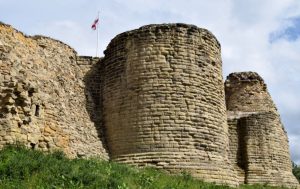
Image: Catherine Lawson/Shutterstock.com
Both a historic site and landmark, Pontefract Castle has a long history of keeping the peace in the north. As well as being the setting for Richard II, the castle has claimed the title of ‘Key to the North’ since the 1200s. Hold Pontefract, they say, and you hold the rest of West Riding. It is largely in ruins now but it is still fun to explore. The best part of this attraction is that they run regular dungeon tours. You will obviously love it but maybe don’t take the kids…
All Saints Church
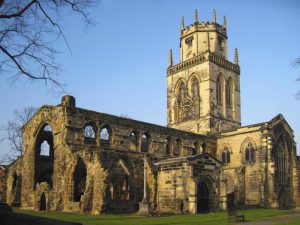
Image: Alastair Wallace/Shutterstock.com
Just like the castle, All Saints Church is still standing and ready for exploration. It’s only a short walk from the castle and dates back to the turn of the 14th Century. If you like architecture its a must-visit.
Cultural Attractions
Take a trip out to Frickley Park. The main thing about this place is that it is undergoing rewilding. This used to be the old mine works. Yorkshire men past would descend into the gravelly pits here and potentially not come back up. The park has had several trees planted in it and is covered with brush and grass. The birds have come back, and there are foxes, deer, and other animals using the space. See how many you can spot.
Take a trip to Pontefract Museum if you want to learn all about the local history. This is a former library building but now houses the history of the town. If you want the history of the castle, you need to visit both.
Recreation
Partially a shopping experience and partially a cultural experience, locals love to spend their weekends hunting out antiques in the local centre. The Magistrates Antique Centre is thus called because it is held in the old magistrates building. It looks palatial, the perfect place for a weekend’s antiquing.
Outdoor Attractions
Take the kids down to Farmer Copley’s. This cool activity farm has a café for adults to enjoy, plus they run seasonal events. You can pick your pumpkin here, buy cheaper eggs than you would find in the supermarket, or visit to buy Christmas decorations. They offer a function spare for parties and have a great farm shop, too.
The locals love spending time in the Brockadale Nature Reserve. This is a protected outdoor space for wildlife around the town. Access the area from Leys Lane between Pontefract and Little Smeaton. You will see fields of wildflowers, woodland, and marshes here. It’s a great location to hike in summer.
Sports and Teams
The local football team is known as the Pontefract Collieries Football Club and has been since Noah was a boy. They play in the Northern Premier League Division One. We didn’t get into the mining in this area properly in this travel guide, but much of Yorkshire has the same experience. The men went down into the pits and a solid percentage of them didn’t come out again. This FC was formed because of those miners, which makes it one of the most important football teams in England.
Pontefract RUFC is another team to get behind. They regularly produce players who go on to represent England on a world stage. They have a junior club program which starts training kids from a young age which might be something to do with all that national fame.
If you prefer hitting a ball instead of carrying or kicking it, check out the local golf club. Pontefract and District golf club opened in 1904. It combines wooded areas with a well-tended green and even a pond.
Let’s not forget that huge racecourse, either. Pontefract Racecourse brings the community together every weekend in the summer season. Go and see a Pontefract horse race for yourself and make sure you wear your best hat.
Where to go Shopping in Pontefract?
There are many shops in the town centre and market area in Pontefract. If you want to spend the day shopping then check out the South Baileygate Retail Park just to the north of town. There is Junction 32 for shopping if you want to head into Castleford. You can head south to the Precinct in Featherstone, too.
There is a Haribo shop outlet in town which is a factory outlet. The Haribo factory is not far from Pontefract. The factory outlet shop sells massive bags, Haribo teddies, and all the factory-grade mistakes that they made in producing products. Get stuck in.
Where to eat and drink in Pontefract?
If you are looking for a wonderful high tea, head to the Blind Pig in the Market Place. If you fancy Italian food, head to the Mamma Mia restaurant on Northgate. If you want a fancy cocktail, on the other hand, check out the Myxology bar. If plain old pints and pub grub are your thing then head to the Winding Wheel, instead.
Other Notable Nearby Attractions
There are loads of cool places to go and explore when you are out West in Yorkshire. Here are the places we recommend you try to see if you are in the area:
- Visit nearby Castleford for a fun day out.
- Check out the wonderful attractions in ancient Ilkley.
- Go walking on the Bronze Age moors outside Keighley.
- Head to Batley and see Fox’s biscuit factory.
- See the beauty of the Calder Valley at Hebden Bridge.
There are always fun things to do in the area surrounding Pontefract. Take the time to explore those surrounding areas and you will find hours of endless activity.
How to get to Pontefract?
The last thing we ought to tell you about Pontefract is how you get there. It’s in West Yorkshire, which is your first clue. Here are the others.
By Road
Follow the A1 north or south.
By Rail
The nearest railway station is Pontefract Monkhill Station on the Northern Line.
By Air
The nearest airport is Leeds Bradford.
By Sea
Out in West Yorkshire, you are landlocked but there are plenty of nice rivers.
Got Five More Minutes?
Still interested in our super awesome location and travel guides? You can find a whole bunch of them on our Website. Otherwise, we appreciate anything you can do to further the cause. If you liked this article, please like it, and share it. A Facebook follow is another great way to help us out. Go on. Consider it your good deed of the day.
